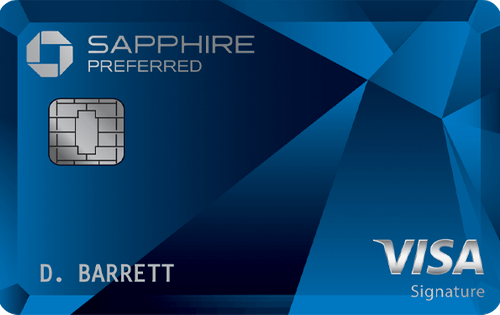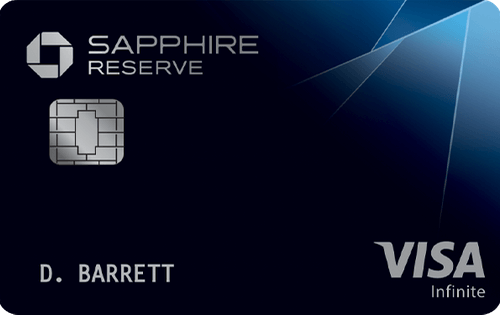
-
United States
-
United Kingdom
|
|
You might be using an unsupported or outdated browser. To get the best possible experience please use the latest version of Chrome, Firefox, Safari, or Microsoft Edge to view this website. |

Chase just announced a change to the Chase Sapphire Preferred credit card. It increased the bonus points from 50,000 to 60,000, bringing the bonus value to $750 in travel when booked through Chase Ultimate Rewards. That increase brings the bonus value in line with the Chase Sapphire Reserve. And that raises an important question: Is the Chase Sapphire Preferred or the Chase Sapphire Reserve the best option now?
I’ve carried the Chase Sapphire Reserve since its launch. Back in the day it offered 100,000 bonus points worth up to $1,500. Such a hefty bonus wasn’t sustainable, and Chase cut it in half back in early 2017. Now with the 10,000 bonus point increase with the Chase Sapphire Preferred, an argument can be made that it’s the better option.
Chase Sapphire Preferred

Most frequently asked questions
How credit cards work ?
The idea behind credit cards is simple: When you use a credit card, you are borrowing money to pay for something. Later on, you must repay what your borrowed. If you take time to pay it back (rather than pay it in full when your credit card statement comes), you’ll be charged interest. The whole credit cards industry rests on this basic premise.
A basic credit card transaction works like this:
What's the difference between Visa and Mastercard?
This is one of the most common questions about credit card companies. Just about every place that takes credit cards takes both Visa and Mastercard, with only a couple of exceptions (such as Visa-only Costco), so consumers are left wondering whether there’s a difference at all.
The most important thing to remember is that neither Visa nor Mastercard issues credit cards. These companies are just payment networks that process transactions. Most of the benefits that come with a card are provided by the card issuer, not the network. And since their acceptance rates are nearly identical, you’re better off focusing on the features of individual cards rather than which network they operate on. Read more about Visa vs. Mastercard.
What's the lowest interest rate on any credit card?
If the goal is realistic, the final step is establishing a time frame for achieving it. Using this process to set money goals for yourself can act as an incentive to break away from the paycheck to paycheck mold and improve your financial situation.
How many credit cards should you have?
If the goal is realistic, the final step is establishing a time frame for achieving it. Using this process to set money goals for yourself can act as an incentive to break away from the paycheck to paycheck mold and improve your financial situation.If the goal is realistic, the final step is establishing a time frame for achieving it. Using this process to set money goals for yourself can act as an incentive to break away from the paycheck to paycheck mold and improve your financial situation.
What's the best credit card company?
HTML Table
If the goal is realistic, the final step is establishing a time frame for achieving it. Using this process to set money goals for yourself can act as an incentive to break away from the paycheck to paycheck mold and improve your financial situation.
| Company | Contact | Country | Country | Country | Country | Country | Country |
|---|---|---|---|---|---|---|---|
| Alfreds Futterkiste | Maria Anders | Germany | Alfreds Futterkiste | Maria Anders | Germany | Maria Anders | Germany |
| Centro comercial Moctezuma | Francisco Chang | Mexico | Alfreds Futterkiste | Maria Anders | Germany | Maria Anders | Germany |
| Ernst Handel | Roland Mendel | Austria | Alfreds Futterkiste | Maria Anders | Germany | Maria Anders | Germany |
| Island Trading | Maria Anders | Germany | Helen Bennett | UK | Alfreds Futterkiste | Maria Anders | Germany |
| Laughing Bacchus Winecellars | Yoshi Tannamuri | Canada | Alfreds Futterkiste | Maria Anders | Germany | Maria Anders | Germany |
| Magazzini Alimentari Riuniti | Giovanni Rovelli | Italy | Alfreds Futterkiste | Maria Anders | Germany | Maria Anders | Germany |
Which is the best Credit card?
Sapphire Chase is one of the best credit card with good apr and good credit.
The Chase Sapphire Preferred now offers 60,000 bonus points when you spend $4,000 in the first three months of opening the account. That’s the good news. In exchange for the increased bonus, Chase no longer waives the $95 annual fee the first year.
The net result is positive for new cardholders, but not by much. The extra 10,000 point bonus is worth $125 if used for travel through Chase Ultimate Rewards. Points normally are worth one cent, but the Preferred card offers a 25% bonus when points are used to book travel through Chase Ultimate Rewards. As a result, the net change is an extra $30.
Chase Sapphire Preferred® Card (Forbes Review)
With its rare mix of high rewards rates and redemption flexibility, this card is a dream for frequent spenders on travel & dining.
Chase Sapphire Preferred® Card (Forbes Review)
With its rare mix of high rewards rates and redemption flexibility, this card is a dream for frequent spenders on travel & dining.

- 2X Points on travel and dining
- Transfer points to travel partners at 1:1 rate
- No points limits, points never expire

- $95 annual fee, not waived in first year
- No intro APR offer
- High regular APR
- Earn 60,000 bonus points after you spend $4,000 on purchases in the first 3 months from account opening. That’s $750 toward travel when you redeem through Chase Ultimate Rewards®
- 2X points on travel and dining at restaurants worldwide & 1 point per dollar spent on all other purchases.
- Get 25% more value when you redeem for airfare, hotels, car rentals and cruises through Chase Ultimate Rewards. For example, 60,000 points are worth $750 toward travel
- Get unlimited deliveries with a $0 delivery fee and reduced service fees on orders over $12 for a minimum of one year on qualifying food purchases with DashPass, DoorDash’s subscription service. Activate by 12/31/21.
- Earn 5X points on Lyft rides through March 2022. That’s 3X points in addition to the 2X points you already earn on travel.
Other features of the card remain the same. Cardholders earn 2x points on travel and dining, and one point on all other purchases. Chase also offers 1:1 point transfers with its airline and hotel partners.
Airline Travel Partners
- Aer Lingus, AerClub
- British Airways Executive Club
- Flying Blue AIR FRANCE KLM
- Iberia Plus
- JetBlue TrueBlue
- Singapore Airlines KrisFlyer
- Southwest Airlines Rapid Rewards®
- United MileagePlus®
- Virgin Atlantic Flying Club
Hotel Travel Partners
- IHG® Rewards Club
- Marriott Rewards®
- The Ritz-Carlton Rewards®
- World of Hyatt®
The card is also free of foreign transaction fees and offers trip cancellation insurance and other travel related insurance coverage.
Chase Sapphire Reserve
 The Chase Sapphire Reserve card remains unchanged. It offers 50,000 bonus points when new cardmembers spend $4,000 in the first three months of opening an account. While this bonus offers 10,000 fewer points than the Preferred, the value when used for travel through Chase Ultimate Rewards is the same–$750. That’s thanks to the 50% bonus the Reserve card offers when you book travel through Chase Ultimate Rewards (the Preferred’s bonus is 25%). That’s an important difference to keep in mind, which we’ll return to in a moment.
The Chase Sapphire Reserve card remains unchanged. It offers 50,000 bonus points when new cardmembers spend $4,000 in the first three months of opening an account. While this bonus offers 10,000 fewer points than the Preferred, the value when used for travel through Chase Ultimate Rewards is the same–$750. That’s thanks to the 50% bonus the Reserve card offers when you book travel through Chase Ultimate Rewards (the Preferred’s bonus is 25%). That’s an important difference to keep in mind, which we’ll return to in a moment.
Most frequently asked questions
How credit cards work ?
The idea behind credit cards is simple: When you use a credit card, you are borrowing money to pay for something. Later on, you must repay what your borrowed. If you take time to pay it back (rather than pay it in full when your credit card statement comes), you’ll be charged interest. The whole credit cards industry rests on this basic premise.
A basic credit card transaction works like this:
What's the difference between Visa and Mastercard?
This is one of the most common questions about credit card companies. Just about every place that takes credit cards takes both Visa and Mastercard, with only a couple of exceptions (such as Visa-only Costco), so consumers are left wondering whether there’s a difference at all.
The most important thing to remember is that neither Visa nor Mastercard issues credit cards. These companies are just payment networks that process transactions. Most of the benefits that come with a card are provided by the card issuer, not the network. And since their acceptance rates are nearly identical, you’re better off focusing on the features of individual cards rather than which network they operate on. Read more about Visa vs. Mastercard.
What's the lowest interest rate on any credit card?
If the goal is realistic, the final step is establishing a time frame for achieving it. Using this process to set money goals for yourself can act as an incentive to break away from the paycheck to paycheck mold and improve your financial situation.
How many credit cards should you have?
If the goal is realistic, the final step is establishing a time frame for achieving it. Using this process to set money goals for yourself can act as an incentive to break away from the paycheck to paycheck mold and improve your financial situation.If the goal is realistic, the final step is establishing a time frame for achieving it. Using this process to set money goals for yourself can act as an incentive to break away from the paycheck to paycheck mold and improve your financial situation.
What's the best credit card company?
HTML Table
If the goal is realistic, the final step is establishing a time frame for achieving it. Using this process to set money goals for yourself can act as an incentive to break away from the paycheck to paycheck mold and improve your financial situation.
| Company | Contact | Country | Country | Country | Country | Country | Country |
|---|---|---|---|---|---|---|---|
| Alfreds Futterkiste | Maria Anders | Germany | Alfreds Futterkiste | Maria Anders | Germany | Maria Anders | Germany |
| Centro comercial Moctezuma | Francisco Chang | Mexico | Alfreds Futterkiste | Maria Anders | Germany | Maria Anders | Germany |
| Ernst Handel | Roland Mendel | Austria | Alfreds Futterkiste | Maria Anders | Germany | Maria Anders | Germany |
| Island Trading | Maria Anders | Germany | Helen Bennett | UK | Alfreds Futterkiste | Maria Anders | Germany |
| Laughing Bacchus Winecellars | Yoshi Tannamuri | Canada | Alfreds Futterkiste | Maria Anders | Germany | Maria Anders | Germany |
| Magazzini Alimentari Riuniti | Giovanni Rovelli | Italy | Alfreds Futterkiste | Maria Anders | Germany | Maria Anders | Germany |
Which is the best Credit card?
Sapphire Chase is one of the best credit card with good apr and good credit.
Chase Sapphire Reserve®
For those who travel and dine enough to justify the $450 annual fee, this card has superior rewards rates and redemption flexibility.
Chase Sapphire Reserve®
For those who travel and dine enough to justify the $450 annual fee, this card has superior rewards rates and redemption flexibility.

- 300X Points on travel and dining
- Transfer points to travel partners at 1:1 rate
- No points limits, points never expire

- High regular APR
- High annual fee of $450, not waived in first year
- No intro APR offer
- Earn 50,000 bonus points after you spend $4,000 on purchases in the first 3 months from account opening. That’s $750 toward travel when you redeem through Chase Ultimate Rewards®
- Named “Best Premium Travel Credit Card” for 2018 by MONEY® Magazine
- $300 Annual Travel Credit as reimbursement for travel purchases charged to your card each account anniversary year
- 3X points on travel immediately after earning your $300 travel credit. 3X points on dining at restaurants & 1 point per $1 spent on all other purchases. $0 foreign transaction fees.
- Get 50% more value when you redeem your points for travel through Chase Ultimate Rewards. For example, 50,000 points are worth $750 toward travel
- 1:1 point transfer to leading airline and hotel loyalty programs
- Access to 1,000+ airport lounges worldwide after an easy, one-time enrollment in Priority Pass™ Select
- Up to $100 application fee credit for Global Entry or TSA Pre✓®
The big differences are in the everyday rewards and annual fee. The Reserve pays 3x points on travel and dining, and one point for all other purchases. In addition, you receive a $300 annual travel credit to apply against travel related purchases. In exchange, however, you pay a $450 annual fee.
As with the Preferred card, the Chase Sapphire Reserve charges no foreign transaction fees and allows for 1:1 transfer of points to partner airlines and hotels. There are, however, some differences with travel insurance.
For example, the Preferred card offers auto rental collision coverage “up to the actual cash value of the vehicle.” The Reserve card’s coverage is up to $75,000. The Reserve card also offers lost luggage coverage up to $3,000 per passenger.
Chase Sapphire Preferred Vs. Chase Sapphire Reserve
So how do these cards stack up and how do you pick the best card for your specific circumstances? Let’s first compare them side-by-side:
| Chase Sapphire Preferred | Chase Sapphire Reserve | |
|---|---|---|
| Signup Bonus | 60,000 points | 50,000 points |
| Value for Travel* | $750 | $750 |
| Value for Non-travel | $600 | $500 |
| Travel and Dining | 2x Points | 3x Points |
| Other Purchases | 1x Points | 1x Points |
| Annual Travel Credit | $0 | $300 |
| Chase Ultimate Reward Bonus | 25% | 50% |
| Annual Fee | $95 | $450 |
*Assumes travel is booked through Chase Ultimate Rewards
Let’s first assume that rewards are used for travel through Chase Ultimate Rewards and that you can use the full $300 annual travel credit offered on the Chase Sapphire Reserve. With those assumptions, three differences stand out.
First is the annual fee. Factoring in the $300 annual travel credit, the Reserve has an effective annual fee of $150 ($450 – $300) while the Preferred has a $95 annual fee. The extra $55 in fees on the Reserve gets you 3x points on travel and dining rather than the 2x offered on the Preferred card. That’s the second difference. And finally, the Reserve offers a 50% bonus when redeeming points through Chase Ultimate Rewards, compared to a 25% bonus on the Preferred card.
So where does that leave us? To make up the effective $55 difference in the annual fee, you would need to spend just $3,660 a year in travel and dining. With the Reserve card’s 3x rewards, you would generate 3,660 additional points over the 2x rewards of the Preferred card. These extra points when used for travel through Chase Ultimate Rewards would have a value of about $55 (3,660 x 0.015).
This should be an easy hurdle for frequent travelers. Still, it’s worth doing the math to make sure which card is best for your specific spending patterns and card usage. For example, we use the Citi Double Cash MasterCard as our everyday card. The 2% cash back is just too good to pass up. We carry the Chase Sapphire Reserve card as well, however, because we spend more than $3,660 a year in travel and dining (mostly travel).
Your mileage may vary.
Chase Ultimate Rewards
A word about Chase Ultimate Rewards. When I first started using the Reserve card, booking travel through Chase was hit or miss. I’d often find the same hotel on another travel website for less money.
Recently I put Chase Ultimate Rewards to the test again when booking a hotel room in New York City. To my surprise, the price offered through Chase was lower than the price offered directly with the hotel. It was a $30 difference on a room costing about $225 a night.
The key is to check prices both through Chase Ultimate Rewards and through other travel sites.
The Fine Print
Maybe it’s the lawyer in me, but I like reading the fine print on financial products. In the case of the Chase Sapphire brand of credit cards, there are several things to keep in mind.
First, you don’t qualify for the bonus points if you’ve received bonus points from a Sapphire card in the past 48 months. Here’s how Chase describes this limitation on its website:
“The product is not available to either (i) current cardmembers of any Sapphire credit card, or (ii) previous cardmembers of any Sapphire credit card who received a new cardmember bonus within the last 48 months.”
Note the language “any Sapphire credit card.” That tells me I wouldn’t qualify for this bonus because I received the Chase Sapphire Reserve bonus back in 2016.
Second, you must spend $4,000 on the card within the first 3 months. Some purchases and other transactions, however, don’t qualify. For example, you can’t spend $4,000 in lottery tickets or money orders. Here are the details from Chase:
“‘Purchases’ do not include balance transfers, cash advances, travelers checks, foreign currency, money orders, wire transfers or similar cash-like transactions, lottery tickets, casino gaming chips, race track wagers or similar betting transactions, any checks that access your account, interest, unauthorized or fraudulent charges, and fees of any kind, including an annual fee, if applicable.)”
Remember that terms and conditions can change, so confirm the terms of any offer directly with the credit card issuer or other financial institution.
More from

Based in Lebanon, I cover travel and personal finance topics for millennials. I'm committed to a life of adventure and have lived in four countries before turning 30. My work appears regularly in Playboy Magazine, Outside Magazine and AFAR Magazine, among others. Before becoming a full-time writer, I was the founding Editor-in-Chief of StepFeed in the Middle East.






